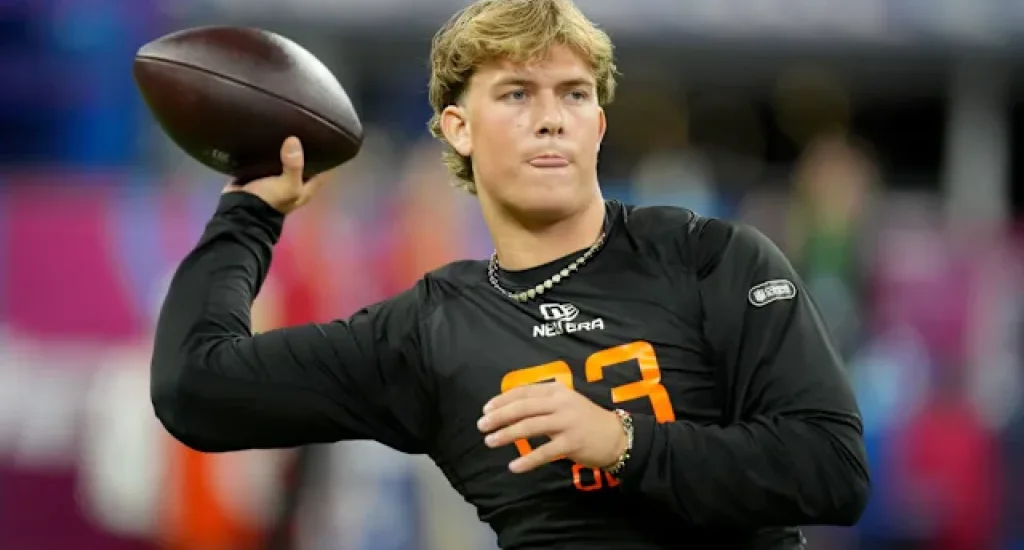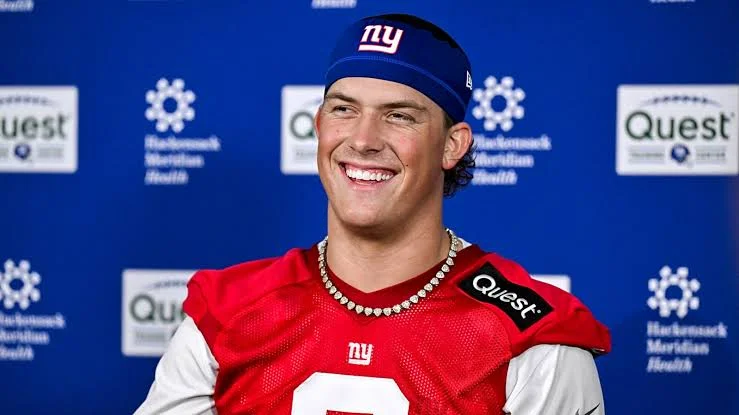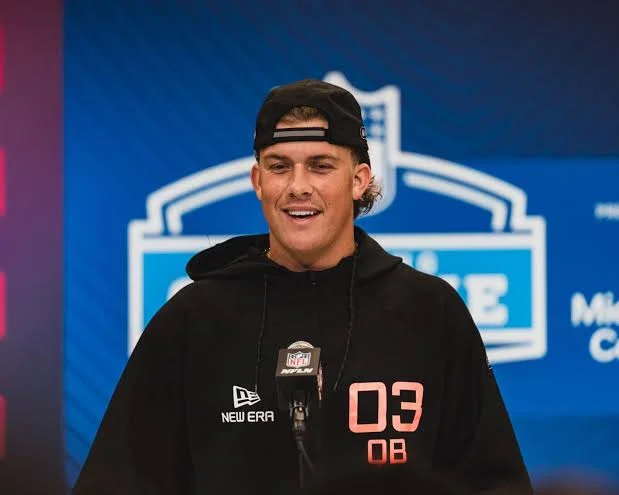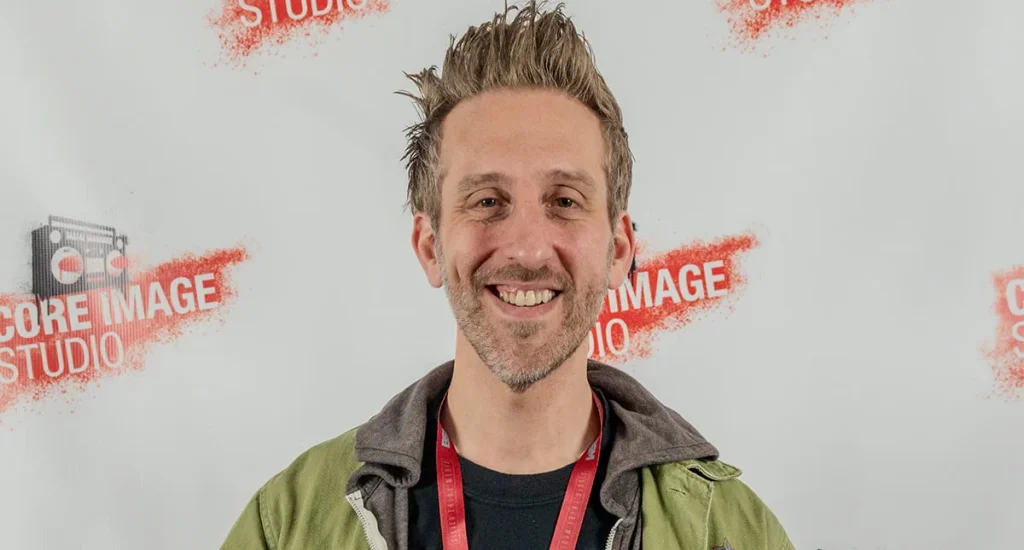
Jaxson Dart Twitter:
How a first-round Ole Miss quarterback went from backup to starter—and what his November struggles reveal about the future of the New York franchise
On a gray November Sunday at MetLife Stadium, Jaxson Dart stood in the pocket as pressure collapsed around him. The rookie quarterback had maybe two seconds before the rush arrived, but those two seconds felt like two lifetimes. He delivered the ball to Theo Johnson for a 15-yard touchdown on the opening drive, and for a moment, you could see what the New York Giants saw when they traded back into the first round to select him.
Then reality reasserted itself. The Giants lost again. The supporting cast remained thin. The offensive line struggled. And Dart, just 22 years old and six starts into his NFL career, learned what separates college dominance from professional survival.
As November 2025 draws to a close, Dart sits at 2-7 with the Giants, having thrown for 1,175 yards, 10 touchdowns, and 3 interceptions through nine weeks. The numbers tell part of the story—a quarterback learning on the fly with a depleted roster. But numbers can't capture what it means to be thrust into starting before you're ready, or what it costs to fail publicly while still figuring out who you are.
This is Jaxson Dart's November—a month of growing pains, flashes of brilliance, and the stubborn refusal to be anything less than what the Giants desperately need him to become.
The Ole Miss Legacy Nobody Expected
The irony isn't lost on anyone in New York: Dart followed Eli Manning as Ole Miss's all-time leader in passing yards, surpassing Manning's 10,119 with 10,617 career yards, and now he's trying to recreate Manning's magic with the same franchise.
At Ole Miss, Dart wasn't just productive—he was historic. His 2024 senior season saw him lead the nation in total offense (4,774 yards), total offense per game (367.2), and passing efficiency (180.7). He set SEC records for consecutive completions. He led Lane Kiffin's offense with surgical precision, completing 69.3% of his passes and throwing 29 touchdowns against just six interceptions.
"Jaxson Dart is one of three Ole Miss quarterbacks taken in the first round behind Archie Manning (1971, No. 2 overall) and Eli Manning (2004, No. 1 overall)," the Ole Miss athletics department proudly announced on draft night. The pressure embedded in that statement could crush most 22-year-olds.
But Dart isn't most 22-year-olds. Raised in Kaysville, Utah, as a member of the Church of Jesus Christ of Latter-day Saints, he chose football over a mission—a decision that still defines his sense of purpose. As a high school senior at Corner Canyon, he threw for 4,691 yards with a state-record 67 touchdowns and just four interceptions, earning Gatorade National Player of the Year honors.
The talent was never in question. The question was always: Could he translate Lane Kiffin's quarterback-friendly system to the unforgiving reality of NFL defenses?
The Rapid Ascension Nobody Planned
The Giants didn't draft Dart to start immediately. They signed Russell Wilson to a one-year deal specifically to give the rookie time—maybe a full season—to learn, adapt, and develop without the pressure of rescuing a franchise.
That plan lasted three games.
After an 0-3 start with Wilson under center, head coach Brian Daboll made the switch. On September 23, 2025, the announcement came: Dart would make his first career start in Week 4 against the undefeated Los Angeles Chargers.
"I met both with Russ yesterday and Jaxson privately, and Russ was nothing but a pro, which is what I would expect him to be. It's my decision. We're going with Jaxson." — Brian Daboll, Giants Head Coach
The timing was brutal. Dart had attempted exactly zero passes in the regular season. He'd appeared in just six total snaps across two games, running the ball twice for zero yards. Now he was being asked to face a Chargers defense allowing just 16.6 points per game—arguably the NFL's most imposing unit.
What happened next shocked everyone: Dart beat the then-undefeated Chargers, completing 13-of-20 passes for 111 yards and adding a rushing touchdown. The Giants won 17-13, and suddenly the narrative shifted from "rookie thrown to the wolves" to "maybe this kid is special."
Two weeks later, Dart defeated the Philadelphia Eagles, completing 17-of-25 passes for 195 yards and rushing 13 times for 58 yards. The Giants were 2-0 with their rookie quarterback. Hope, that dangerous thing, began spreading through the fanbase.
Then November happened.
The Reality Check of November
Professional football has a way of humbling even the most talented rookies, and November 2025 has been Dart's education in adversity. The wins stopped coming. The losses piled up. The supporting cast—already thin—got thinner.

Malik Nabers, the Giants' first-round wide receiver and Dart's primary weapon, tore his ACL. Running back Cam Skattebo battles injuries. The offensive line, never elite to begin with, has struggled to give Dart consistent protection. What looked like a promising start has devolved into survival mode.
Yet somehow, through all of it, Dart continues to earn premium grades from Pro Football Focus, finishing Week 9 with an overall grade of at least 73.0 despite the loss to San Francisco. He delivered two big-time throws in the fourth quarter, marking his second consecutive week with multiple big-time throws and no interceptions.
"The rookie dual-threat was New York's most successful rusher on just nine carries, recording two 10-plus-yard runs, averaging 7.0 yards per attempt, and scoring the team's only rushing touchdown," the PFF report noted. When your quarterback leads the team in rushing effectiveness, it says something about both his talent and your roster construction.
This dual-threat capability has become Dart's survival mechanism. Much like other young players fighting to reclaim their promise, Dart compensates for systemic weaknesses by expanding his game. He's not just a passer anymore—he's a playmaker who happens to throw the ball.
The Scouting Report Reality
The pre-draft evaluations of Dart read like prophecy now. PFF's March 2025 scouting report noted that "while Dart brings really good qualities and shows flashes in certain areas, he is without a defining characteristic to be an elite prospect".
The report identified Dart's greatest strengths: decisive decision-making when he could quickly identify coverage, excellent understanding of velocity and touch on different throws, and elite performance when throwing to his initial read (92.9 PFF passing grade, second-highest in FBS).
But it also identified his weakness: When forced off his initial read to the other side of the field, his passing grade dropped to 60.3, ranking 63rd in FBS. Lane Kiffin's offense at Ole Miss didn't typically require full-field progressions, focusing instead on one side of the field. That limitation was going to be tested in the NFL.
November has been that test.
Watch Dart in November 2025, and you see flashes of both realities. When given time, he's surgical—placing the ball where only his receivers can catch it, demonstrating the touch and accuracy that made him an All-SEC selection. But when the pocket collapses—which happens frequently behind the Giants' offensive line—he reverts to survival mode, sometimes losing mechanical discipline in his desperation to make plays.
The Brian Daboll Philosophy
Daboll knows something about developing quarterbacks. He was Josh Allen's offensive coordinator in Buffalo during Allen's transformation from raw athlete to MVP-caliber quarterback. The comparisons aren't perfect—Allen was always a bigger, stronger athlete with a cannon arm—but the development philosophy applies.
"I like the way he plays. I like his competitive fire. I like his accuracy. I like his ability to push the ball down the field, his athletic ability to run with the football. I think this guy's got better every year he's played. He's a leader. He was smart. He has the attributes that we were looking for." — Brian Daboll on Jaxson Dart
Daboll's plan for Dart was clear from the start: let Russell Wilson start the season, give the rookie time to absorb the NFL game, then transition when ready. The 0-3 start forced an acceleration of that timeline, but Daboll's commitment to development hasn't wavered.
"Russ will be our starter, and that's how it will be once we get started here in the spring," Daboll said initially. "Look, the process of developing a quarterback is just that. So, we're going to do everything we can to develop him and bring him along."
That development now happens in real time, under the unforgiving lights of NFL Sundays. Every mistake gets analyzed. Every success gets contextualized. Every week presents new defensive looks Dart has never seen before.
Similar to how media figures must adapt their approaches when circumstances change, Daboll has had to adjust his quarterback development plan on the fly. The results have been mixed, but the commitment remains constant.
The Supporting Cast Problem
No quarterback succeeds alone, and Dart's challenges are compounded by the roster around him. Losing Malik Nabers—who provided a safety valve and big-play threat—fundamentally altered the offense's ceiling. Without a true WR1, defenses can focus more attention on limiting Dart's other options.
The running game, never dynamic to begin with, has been inconsistent. Cam Skattebo shows flashes but isn't healthy enough to be the workhorse back the Giants need. This forces Dart into more obvious passing situations where defenses can pin their ears back and rush.
The offensive line, featuring several young and inexperienced players, has struggled with protection consistency. Pre-draft analysis noted that "when clean, Dart eviscerates defenses with a low rate of potential turnovers. However, Dart shows a different side when there's a rusher coming toward him".
The Giants' offensive line doesn't keep him clean nearly often enough.
This creates a vicious cycle: Dart faces pressure, his mechanics deteriorate, turnovers increase, the offense stalls, the defense gets worn down, and losses accumulate. Breaking this cycle requires either dramatic improvement from Dart under duress or roster upgrades the Giants can't make mid-season.
The Dual-Threat Dimension
If there's a silver lining in November's struggles, it's the emergence of Dart as a legitimate dual-threat quarterback. His rushing ability—13 rushing attempts for 58 yards against Philadelphia, leading the team in rushing against San Francisco—adds a dimension opposing defenses must account for.
This wasn't necessarily expected. At Ole Miss, Dart was more of a "quarterback who can run" than a "running quarterback." He rushed for 1,498 yards and 12 touchdowns on 371 attempts over three seasons—productive, but not elite.
In the NFL, that rushing ability has become survival. When receivers aren't open and protection breaks down, Dart's legs give him a third option beyond forcing throws or taking sacks. His rushing touchdown against the Chargers in his debut wasn't a designed run—it was recognition and execution in the moment.

"The rookie dual-threat was New York's most successful rusher," isn't a sentence anyone expected to write regularly about a first-round quarterback. But it's become Dart's reality, and he's embraced it.
The concern, of course, is durability. At 6'2" and 225 pounds, Dart isn't small, but he's not built like Cam Newton either. Every designed run, every scramble, every hit he absorbs increases injury risk. For a franchise desperately hoping he's their long-term answer, that risk calculation matters.
The Statistical Profile of Growth
Through nine weeks, Dart's statistics paint a picture of a quarterback learning to survive before he can thrive. His 1,175 passing yards rank 28th among NFL quarterbacks, his 10 touchdowns tie for 22nd, and his 3 interceptions tie for 42nd. His 61.2 QBR ranks 14th—respectable for a rookie thrust into a difficult situation.
But raw numbers miss context. Dart is working with arguably the NFL's thinnest receiving corps after Nabers' injury. He's operating behind a bottom-tier offensive line. He's playing for a team that was 0-3 before he took over, inheriting organizational dysfunction he didn't create.
Compare his situation to other recent rookie quarterbacks, and the challenges become clearer. C.J. Stroud inherited a Texans team with elite offensive pieces. Bryce Young got weapons in Carolina (even if the overall situation was difficult). Dart got handed the keys to a sinking ship and told to keep it afloat.
The fact that he's kept the Giants competitive—losing close games rather than getting blown out—suggests something about his competitiveness and processing speed. This isn't a rookie drowning; this is a rookie treading water while learning to swim.
The Manning Comparisons
It's impossible to discuss a Giants quarterback who played at Ole Miss without invoking Eli Manning. The comparisons are inevitable, burdensome, and mostly unfair—Manning had years to develop before winning Super Bowls, and he had significantly better supporting casts during his championship runs.
But there are parallels worth noting. Manning also faced early struggles. His first season (2004) saw him throw 18 touchdowns and 18 interceptions while posting a 75.9 passer rating. The Giants went 6-10. Critics questioned whether he was worth the first overall pick (he was drafted first by San Diego before being traded to the Giants).
Manning's development wasn't linear—it was gradual, with setbacks and breakthroughs scattered across seasons. He didn't become "Eli Manning, Super Bowl MVP" overnight. He became that through years of work, roster improvements, and learning from failure.
Dart has time. He's 22 years old in November 2025. Manning didn't win his first Super Bowl until 27. The question isn't whether Dart can replicate Manning's success immediately—it's whether the Giants will give him the time and support Manning received.
The Preseason Prophet
Before the season started, before Wilson was benched, before Dart's emergency promotion, the preseason offered glimpses of what he could become. Dart completed 32 of 47 preseason passes for 372 yards, three touchdowns, and no interceptions, posting a 113.1 passer rating.
More impressively, he showed poise under pressure. Against the Bills, he stood in the pocket despite defensive tackle T.J. Sanders breathing down his neck and delivered a perfect 29-yard touchdown strike to Lil'Jordan Humphrey. He got hit immediately after release, popped up, and celebrated with his teammates.
"I thought guys were making great plays for me," Dart said after one preseason game. "I was just trying to distribute the ball to the playmakers we have."
That humility—crediting teammates, deflecting praise—has remained consistent even as November's losses accumulate. It's the kind of leadership quality that can't be taught, only observed and appreciated.
The November Lesson
If September and October were about surviving the unexpected promotion, November has been about confronting reality. The Giants aren't a playoff team. The roster has significant holes. Dart isn't ready to carry a franchise alone—and he shouldn't have to be.
But November has also revealed Dart's character. He hasn't folded under pressure. He hasn't blamed teammates or coaches publicly. He hasn't lost the competitive fire Daboll praised. Instead, he's absorbed lessons at an accelerated pace, processing NFL complexity in real time while his peers from other draft classes watch from the sidelines.
Much like how young athletes must navigate unexpected challenges, Dart is learning that professional sports don't follow neat developmental timelines. Sometimes you get thrown into the fire before you're ready. What matters is whether you burn or whether you forge yourself into something harder.
The 2-7 record will be what casual observers remember about November 2025. But people who actually watch Dart play—who see him leading the team in rushing because he has no other options, who notice him delivering big-time throws in the fourth quarter despite the game being out of reach—see something different.
They see a quarterback who isn't there yet but refuses to stop trying to arrive.
Looking Ahead
As November gives way to December, the Giants face a decision: continue developing Dart through real games, or shut him down to avoid further risk if the season is truly lost. Daboll has indicated Dart remains the starter for the remainder of the season, prioritizing long-term development over short-term wins.
"We're going to get him ready to play this week and the remainder of the season," Daboll said when announcing the quarterback change. "He's going to do everything he can."
This commitment matters because quarterback development isn't linear. Patrick Mahomes sat behind Alex Smith. Aaron Rodgers sat behind Brett Favre. Jordan Love sat behind Rodgers. Sometimes incubation works. Sometimes immediate immersion works. There's no single path to success.
Dart's path is the latter—trial by fire, learning through failure, developing scar tissue that will serve him later. It's painful to watch, frustrating for fans desperate for immediate success, and exactly what might make him the quarterback the Giants need in 2026 and beyond.
The question isn't whether Dart can succeed in November 2025. That ship has sailed—the roster is too thin, the situation too difficult. The question is whether November 2025 will have taught him lessons that lead to success in future Novembers, when the stakes are higher and the support is better.
The Broader Context
Dart's struggles exist within a broader context of Giants dysfunction. This is a franchise that moved on from Daniel Jones after years of trying to make that relationship work. They're on their third quarterback situation in as many years. The front office and coaching staff are likely on the hot seat heading into 2026.
This organizational instability affects everything. When coaches know they might be fired after the season, long-term development becomes harder to prioritize. When general managers fear for their jobs, they make desperate moves rather than patient ones.
Dart has been dropped into this swirl of desperation and dysfunction with the expectation that he'll somehow stabilize it. That's an unfair burden for a 22-year-old, no matter how talented.
Similar to how media personalities must navigate changing landscapes, Dart must adapt to circumstances beyond his control while maintaining focus on what he can control: his preparation, his performance, his leadership.
The Hope Underneath
For all of November's difficulties, there's reason for optimism buried in the statistics and game film. Dart's PFF grades remain strong despite the losses. His ability to avoid turnovers—just 3 interceptions through nine weeks—suggests solid decision-making under pressure. His rushing ability adds a dimension the Giants haven't had at quarterback in years.
More importantly, he hasn't been broken by adversity. Some rookie quarterbacks crumble when thrown into impossible situations—their confidence shatters, their mechanics deteriorate, their competitive fire dims. Dart has shown none of those warning signs.
He still believes he can win. He still competes on every snap. He still celebrates teammates' successes and absorbs coaching without defensiveness. These intangible qualities—harder to measure than yards and touchdowns—often predict long-term success better than raw statistics.
"I expect him to prepare, go out here and get better each time he plays. It's not always going to be perfect, but I do think that he has the right makeup and athleticism. Look, we're going to do everything we can to help him be the best player." — Brian Daboll on developing Jaxson Dart
The Verdict on November
November 2025 won't be remembered as Jaxson Dart's finest month. The losses outnumber the wins. The supporting cast crumbled. The dream scenario—rookie quarterback rescues franchise, leads improbable playoff run—didn't materialize.
But November also won't be remembered as a disaster. Dart showed he belongs in the NFL. He demonstrated toughness, processing speed, and the kind of competitive fire that can't be coached. He made mistakes a 22-year-old makes, but he didn't make the catastrophic errors that end careers.
For Giants fans starving for hope after years of quarterback instability, that might have to be enough for now. Dart isn't Eli Manning yet. He might never be. But in November 2025, through losses and struggles and learning experiences, he's shown he might become something—a legitimate franchise quarterback who learned resilience by surviving when he wasn't ready.
The Ole Miss legend surpassed Eli Manning's passing record in college. Now he's trying to live up to Manning's legacy in New York—one difficult November at a time. The story isn't finished. It's barely begun.
And that, ultimately, is what November 2025 represents for Jaxson Dart: not an ending, but a beginning. Not a verdict, but a chapter. Not failure, but education paid for in real time under the lights of NFL Sundays.
The 2-7 record will fade from memory. What remains will be the image of a young quarterback, leading his team in rushing because he had no better options, delivering big-time throws in the fourth quarter of lost games, refusing to quit when quitting would have been understandable.
That's who Jaxson Dart is in November 2025. Whether that's who he'll be remembered as depends on what he does with the lessons this month has taught him. The Giants, and their long-suffering fans, are betting everything that those lessons stick.
Related Articles



Eric Bickel's Twitter Presence: The Steak King and Sauna King of Sports Radio
November 03, 2025

